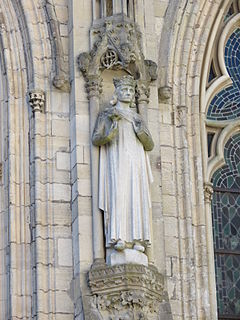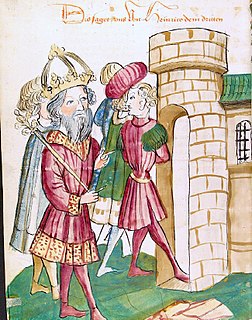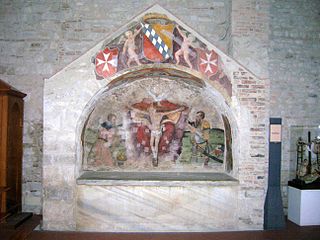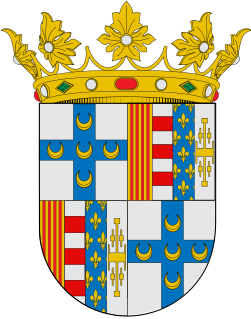See also
- Qaymar, an Iraqi dairy product made out of water buffalo milk
| This page or section lists people that share the same given name. If an internal link led you here, you may wish to change that link to point directly to the intended article. |
Gaimar, Guaimar, or Waimar is a Germanic given name that historically could refer to:
| This page or section lists people that share the same given name. If an internal link led you here, you may wish to change that link to point directly to the intended article. |

Drogo of Hauteville was the second Count of Apulia and Calabria (1046–51) in southern Italy. Initially he was only the leader of those Normans in the service of Prince Guaimar IV of Salerno, but after 1047 he was a territorial prince owing fealty directly to the Emperor.

Guaimar IV was Prince of Salerno (1027–1052), Duke of Amalfi (1039–1052), Duke of Gaeta (1040–1041), and Prince of Capua (1038–1047) in Southern Italy over the period from 1027 to 1052. He was an important figure in the final phase of Byzantine authority in the Mezzogiorno and the commencement of Norman power. He was, according to Amatus of Montecassino, "more courageous than his father, more generous and more courteous; indeed he possessed all the qualities a layman should have—except that he took an excessive delight in women."

Pandulf IV was the Prince of Capua on three separate occasions.
Guaimar III was the Lombard prince of Salerno from around 994 to his death. Under his reign, Salerno entered an era of great splendour. Opulenta Salernum was the inscription on his coins. He made Amalfi, Gaeta and Sorrento his vassals and annexed much of Byzantine Apulia and Calabria.
Gaitelgrima is a Lombard feminine name. There are several notable Gaitelgrimas in history. The identities of these five women are often confused because they were all closely related to each other and to two men: Guaimar III of Salerno and his son, Guaimar IV; they were the princes of Salerno from about 983 to 1027 and from 1027 to 1052.

William of Hauteville was one of the younger sons of Tancred of Hauteville by his second wife Fressenda. He is usually called Willermus instead of Wilelmus in Latin annals and so is often called Guillerm instead of Guillaume in French. He left Normandy around 1053 with his elder half-brother Geoffrey and full brother Mauger.
Guaimar I was the prince of Salerno from 880, when his father entered the monastery of Monte Cassino in August. His parents were Prince Guaifer and Landelaica, daughter of Lando I of Capua. From 877, he was associated with his father on the throne, a practice which had begun with the previous dynasty and continued until the end of Salernitan independence in 1078.
Guaimar II was the Lombard prince of Salerno from 901, when his father retired to a monastery, to his death. His father was Guaimar I and his mother was Itta. He was associated with his father in the principality from 893. He was responsible for the rise of the principality: he restored the princely palace, built the palace church of San Pietro a campanile, and restored gold coinage.
Landulf II, called the Red, was the Lombard prince of Benevento and prince of Capua from 939 or 940, when his father, Landulf I, first associated him with the government. His mother was Gemma, daughter of Athanasius of Naples. He may have been associated as early as 933, when his elder brother, Atenulf III, was made co-regent. His uncle Atenulf II died in 940 and it is likely that Landulf served as a replacement. Landulf married Yvantia on an unknown date.

Medieval Amalfi was ruled, in the tenth and eleventh centuries, by a series of dukes, sometimes called dogi, corresponding with the republic of Venice, a maritime rival throughout the Middle Ages. Before the title of Duke of Amalfi was formally established in 957, various patricians governed the territory. Amalfi established itself as one of the earliest maritime trading powers renowned throughout the Mediterranean, competing with northern European cities.
Athanasius was the Bishop and Duke of Naples from 878 to his death. He was the son of Gregory III and brother of Sergius II, whom he blinded and deposed in order to seize the throne while he was already bishop.
Guaimar II was the Duke of Amalfi, ruling alongside his father, Manso II, and under the suzerainty of his namesake, Guaimar IV of Salerno, from 1047, when his father first associated him, to his and his father's deposition in 1052 by his uncle, John II, after the assassination of the Prince of Salerno.

The Lombard Principality of Salerno was a South Italian state, formed in 851 out of the Principality of Benevento after a decade-long civil war. It was centred on the port city of Salerno. Although it owed allegiance at its foundation to the Carolingian emperor, it was de facto independent throughout its history and alternated its allegiance between the Carolingians and their successors in the West and the Byzantine emperors in the east.
Sergius III was the duke of Amalfi from 1069, when he succeeded his father John II, until his death. He was first appointed co-regent by his father in 1031. He and his father were expelled from Amalfi by his grandmother and uncle, Maria and Manso II, in April or May 1034.

The Norman conquest of southern Italy lasted from 999 to 1139, involving many battles and independent conquerors. In 1130, the territories in southern Italy united as the Kingdom of Sicily, which included the island of Sicily, the southern third of the Italian Peninsula, the archipelago of Malta, and parts of North Africa.
Landulf of Conza, a Lombard nobleman, was briefly Prince of Benevento in 940 and then briefly Prince of Salerno in 973. The son of Atenulf II of Benevento, Landulf ruled on his father's death (940) as co-prince with his uncle, Landulf I, who soon sent him into exile. He initially took refuge at the court of Marinus II of Naples, from where he sought shelter in Salerno through his sister, Gaitelgrima, the second wife of Prince Guaimar II of Salerno. This he received and he was soon appointed gastald of Conza, while his sons—Landenulf, Landulf, Indulf, and Guaimar—were invested with land in Salerno. The Chronicon Salernitanum, which is the most important source for Landulf's life, names the counties of Marsi, Sarno, and Lauro as those of Guaimar, Indulf, and Landenulf, respectively, but does not name a county for Landulf.

The County of Apulia and Calabria, later the Duchy of Apulia and Calabria, was a Norman country founded by William of Hauteville in 1042 in the territories of Gargano, Capitanata, Apulia, Vulture, and most of Campania. It became a duchy when Robert Guiscard was raised to the rank of duke by Pope Nicholas II in 1059.
Guaimar II may refer to:
Pandulf III was briefly the Prince of Salerno from around 3 to 10 June 1052. He was the eldest of four brothers of Gemma, wife of Prince Guaimar IV. He seized the throne in a coup d'état, when he and his brother assassinated Guaimar. He reigned for only a week before he was forced to step down and was promptly murdered.